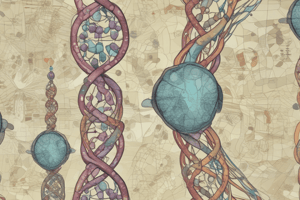Podcast
Questions and Answers
What is the primary purpose of the human genome project?
What is the primary purpose of the human genome project?
- To analyze protein functions
- To study the effects of mutations on phenotypes
- To identify all the genes in the human genome (correct)
- To develop new sequencing methods
What distinguishes a genetic map from a physical map?
What distinguishes a genetic map from a physical map?
- A genetic map is used for RNA sequencing, while a physical map is used for DNA sequencing.
- A genetic map is based on phenotypic markers, while a physical map is based on the actual DNA sequence. (correct)
- A genetic map includes only coding DNA, while a physical map includes both coding and non-coding DNA.
- A genetic map shows the physical distance between genes, while a physical map shows their relative positions.
Which method utilizes dideoxynucleotides to terminate DNA synthesis during sequencing?
Which method utilizes dideoxynucleotides to terminate DNA synthesis during sequencing?
- Shotgun sequencing
- Clone-contig method
- Sanger sequencing (correct)
- Next-generation sequencing
Which of the following best describes proteomics?
Which of the following best describes proteomics?
What is the function of the BLAST tool in bioinformatics?
What is the function of the BLAST tool in bioinformatics?
Flashcards
Genomics
Genomics
The study of an organism's complete set of genes and their interactions.
Genetic map
Genetic map
A map showing the relative positions of genes on a chromosome, based on recombination frequencies.
Physical map
Physical map
A map showing the exact physical locations of genes and other DNA markers on a chromosome.
Clone-contig sequencing
Clone-contig sequencing
Signup and view all the flashcards
Shotgun sequencing
Shotgun sequencing
Signup and view all the flashcards
Study Notes
Major Components of Genomics
- Genomics is the study of an organism's entire genome, including its genes, non-coding DNA, and structure.
- Key components include the study of sequences, base pairs, chromosome maps, genetic maps, physical maps, and functional genomics.
- Bioinformatics tools play a crucial role in analyzing large genomic datasets.
Genetic Map vs. Physical Map
- A genetic map shows the relative positions of genes or other markers along a chromosome based on recombination frequency. A genetic map uses map units or centimorgans. It is often used to order genes within a chromosome.
- A physical map depicts the actual physical distance between markers on a chromosome in terms of base pairs (bp). It uses kilobase pairs (kb) or megabase pairs(Mb) and reflects the precise location of sections of DNA.
- Example: A genetic map might show that two genes are 10 map units apart, suggesting they are located relatively far apart. A physical map, in contrast, could show the same two genes to be1,000- kb apart, which is a more precise measure.
DNA Sequencing Methods
- Automated sequencing utilizes chain-terminating nucleotides (dideoxynucleotides) to determine the order of bases in a DNA molecule. This approach is the foundational method for DNA sequencing.
- Next-generation sequencing employs high-throughput technologies offering faster, cheaper, and scalable sequencing options compared to earlier methods. It can analyze millions or even billions of DNA sequences at once. This approach is fundamental for handling large genomic studies.
Clone-Contig vs. Shotgun Sequencing
- Clone-contig: First, researchers create overlapping fragments of large target DNA sequences through cloning, then, they assemble the contiguous sequence (contig). This method was critical for the Human Genome Project, especially when dealing with large chromosome sections.
- Shotgun: A DNA molecule is broken into random fragments, sequenced individually, with overlapping sequences identified and the entire sequence is assembled. This approach is commonly used in next-generation sequencing projects.
Genome Annotation
- Genome annotation is the process of identifying genes, regulatory regions, and other functional elements in a genome sequence.
- Annotation interprets the meaning of DNA sequences to explain specific gene functions and patterns.
Non-coding DNA Roles
- Non-coding DNA regions do not code for proteins but play important regulatory roles.
- It might influence gene expression, DNA replication, and chromosome structure.
- Non-coding DNA sequences can also be involved in evolution through mutation.
- It represents an area of ongoing research in genomics.
Comparative Genomics, Functional Genomics, and Proteomics
- Comparative genomics: Compares genomes of different organisms to understand evolutionary relationships and identify conserved or diverged genes.
- Functional genomics: Examines the function of genes and their products within an organism's cellular processes, utilizing tools like DNA microarrays and proteomics.
- Proteomics: The study of the full protein set (proteome) encoded by a genome. This includes examining its structure, function, and interactions within cells.
Applications of Genomics
- Medicine & Healthcare: Identifying disease-causing genes, personalized medicine, drug target discovery, and diagnostics for genetic diseases.
- Agriculture: Developing crops with enhanced traits, improving livestock breeding, and understanding plant evolution.
- Environmental science: Studying microbial communities in ecosystems, understanding biodiversity, monitoring pollution, and bioremediation.
- Evolutionary biology: Understanding the history and development of organisms, tracing evolutionary relationships and tracing common ancestry.
Studying That Suits You
Use AI to generate personalized quizzes and flashcards to suit your learning preferences.



